
Erigeron divergens is a species of flowering plant in the family Asteraceae known by the common name spreading fleabane. It is native to western North America.

Agoseris glauca is a species of flowering plant in the family Asteraceae known by the common names false dandelion, pale agoseris, prairie agoseris, and short-beaked agoseris. It is native to western North America.

Symphyotrichum ascendens is a species of flowering plant in the family Asteraceae known by the common names western aster, long-leaved aster, and Rocky Mountain aster. Blooming July–September, it is native to western North America and can be found at elevations of 500–3,200 m (1,600–10,500 ft) in several habitats.

Crepis modocensis is a species of flowering plant in the family Asteraceae known by the common name Modoc hawksbeard.
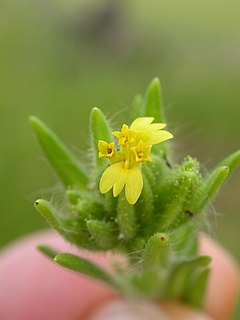
Madia glomerata is a species of flowering plant in the family Asteraceae known by the common name mountain tarweed.

Nothocalais troximoides is a species of flowering plant in the family Asteraceae known by the common name sagebrush false dandelion. It is native to western North America, including British Columbia and the northwestern United States, where it grows in sagebrush and other plateau and mountain habitat types. It is a perennial herb growing from a thick caudex and producing a woolly stem up to about 25 cm tall. The leaves are located around the base of the stem and often have crinkled wavy edges, and sometimes a thin coat of small hairs. They measure up to 30 cm long. The inflorescence is a flower head lined with green, sometimes purple-speckled, phyllaries and containing many yellow ray florets and no disc florets. The fruit is a cylindrical achene up to 1.3 cm long not including the large pappus of up to 30 silvery white bristles which may be an additional 2 cm in length.

Senecio integerrimus is a species of flowering plant in the aster family known by the common names lambstongue ragwort and tall western groundsel. It is native to western and central North America, where it grows in grassland, forest, and other habitat. It is a biennial or perennial herb producing one or a few erect stems 20 to 70 centimeters tall from a caudex with fleshy shallow roots. The linear to lance-shaped or triangular leaves are primarily basal, with blades up to 25 cm (10 in) long. The herbage is slightly hairy to woolly or cobwebby. The inflorescence bears several flower heads in a cluster, the middle, terminal head often largest and held on a shorter peduncle, making the cluster look flat. The heads contain many disc florets and usually 8 or 13 ray florets which may be yellow to cream to white in color. Some heads lack ray florets.
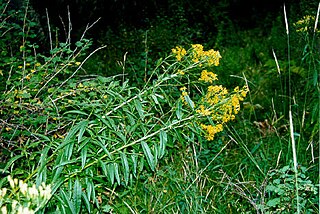
Senecio serra is a species of flowering plant in the aster family known by the common names tall ragwort and sawtooth groundsel. It is native to the western United States, where it can be found in several types of habitat, including sagebrush and woodlands. It is a perennial herb producing a single erect stem or a cluster of stems from a branched, woody caudex. The plant can exceed two meters in height. It is hairless in texture, with young plants sometimes appearing fuzzy, and green to red-tinged in color. The leaves have lance-shaped blades up to 20 centimeters long borne on short petioles, the leaves occurring evenly all along the stems. The inflorescence is a spreading array of many flower heads, each lined with green- or black-tipped phyllaries. The heads contain yellow disc florets and 5 to 8 yellow ray florets each under a centimeter long.
Sphaeromeria potentilloides is a species of flowering plant in the aster family known by the common names cinquefoil false sagebrush and fivefinger chickensage. It is native to the western United States, where it is known from the Great Basin and surrounding regions. It grows in moist areas, especially places with alkaline substrates such as hot springs and seeps. This perennial herb produces spreading stems from a woody caudex. The gray-green woolly leaves are divided into several lobes or leaflets which are subdivided into smaller lobes. The inflorescence is generally a cluster of a few flower heads lined with hairy phyllaries and containing yellow disc florets. There are no ray florets. The fruit is a tiny ribbed achene which swells up and becomes gluey in texture when it is moistened.

Stenotus acaulis is a species of flowering plant in the family Asteraceae known by the common name stemless mock goldenweed.
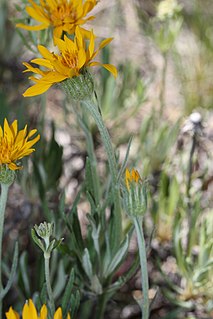
Stenotus lanuginosus is a species of flowering plant in the family Asteraceae known by the common names woolly mock goldenweed and woolly stenotus.
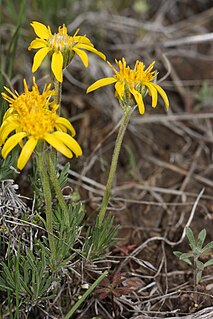
Nestotus stenophyllus is a species of flowering plant in the family Asteraceae known by the common name narrowleaf mock goldenweed. It is native to the western United States, especially the inland Pacific Northwest and northern Great Basin, where it grows in sagebrush habitat. It is a small, clump-forming perennial herb growing up to about 12 centimeters tall. The rough-haired, glandular leaves are 1 or 2 centimeters long and linear to lance-shaped. The inflorescence is a solitary flower head atop an erect peduncle. The hairy head has several yellow disc florets each around a centimeter long and at the center many yellow disc florets. The fruit is a silky-haired achene tipped with a white pappus.

Townsendia scapigera is a species of flowering plant in the family Asteraceae known by the common name tufted Townsend daisy. It is native to the western United States, where it grows in mountains, sagebrush, and other habitat.
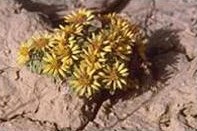
Townsendia aprica is a rare species of flowering plant in the family Asteraceae known by the common name Last Chance Townsend daisy. It is endemic to Utah in the United States, where it is known from three counties. It faces a number of threats and it is a federally listed threatened species of the United States.
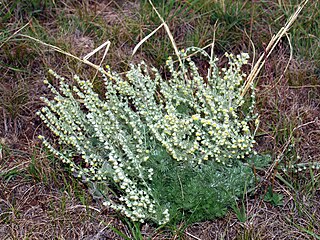
Artemisia frigida is a widespread species of flowering plant in the aster family, which is known as the sunflower family. It is native to Europe, Asia, and much of North America. In parts of the north-central and northeastern United States it is an introduced species.

Cryptantha subcapitata is a species of flowering plant in the borage family known by the common names Owl Creek miner's candle, Wallowa cat's eye, and Wallowa cryptantha. It is endemic to Wyoming in the United States, where it is limited to the Owl Creek and Bridger Mountains in Fremont County. There are three populations, with a total of about 38,000 individuals.
Agoseris parviflora is a North American species of flowering plants in the family Asteraceae known by the common name Steppe agoseris or sagebrush agoseris or false dandelion. It is found in the Western United States primarily in the Great Basin and the region drained by the Colorado River but also in the eastern foothills of the Sierra Nevada and on the western edge of the Great Plains. Its range extends from eastern Oregon and eastern California to Wyoming, Colorado, and New Mexico, with a few isolated populations in western Kansas and western South Dakota.
Brickellia simplex, the Sonoran brickellbush, is a North American species of flowering plants in the family Asteraceae. It is native to northern Mexico and the southwestern United States.
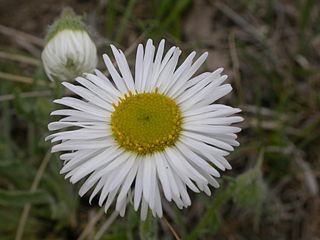
Erigeron ochroleucus is a North American species of flowering plant in the family Asteraceae, called the buff fleabane or buff daisy. It is native to western Canada and the western United States from Alaska and Yukon southeast as far as Colorado and Nebraska.

Solidago simplex, the Mt. Albert goldenrod or sticky goldenrod, is a North American plant species in the genus Solidago of the family Asteraceae. It is widespread across much of Canada, parts of the United States, and northeastern Mexico.

















